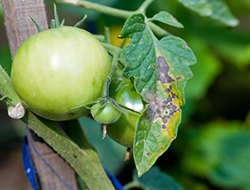5 Ways to Prevent Vegetable Diseases
Key chores you do in the garden’s quiet season can pave the way for fewer disease outbreaks next year. It begins with a thorough end-of-season cleanup. Adopt these five easy gardening habits to prevent vegetable diseases.

Clean up the garden
Give your vegetable garden an end-of-season cleaning. Remove leftover plant material and pull remaining stems.
Gather fallen leaves – from vegetable plants or trees. Many vegetable diseases survive winter on infected plant parts; insects that spread diseases often overwinter in autumn leaves. In cold regions, do a final cleanup after a hard freeze.
If you're not following a no-till growing style, turn soil to disrupt overwintering diseases. Turning soil also helps to speed decomposition of any remaining root systems.
Aim for weed-free
Have a zero tolerance policy for weeds in and around your vegetable garden. Some weeds can host the same diseases that attack vegetables – and give those diseases a place to survive winter. At the end of your growing season, clean up all traces of weeds in and near your vegetable garden.
Keep crops moving
When you grow crops from the same plant family in the same spot year after year, disease organisms can build up in soil, leading to intense outbreaks.
For instance, tomato, eggplant and pepper are in the same family. Cabbage family members include broccoli, Brussels sprouts, collard greens and kale. For best disease prevention, you would rotate crops on a three-year cycle. This means you don’t grow any crops from a particular plant family in the same spot for three years. Once you develop a rotation plan for your garden, you can re-use it indefinitely.
Nix most volunteers
In a home vegetable garden, an overlooked brassica stem will occasionally sprout as the growing season begins, or a surprise seedling will appear in the midst of last year’s tomato patch. Because crop rotation plays such a key role in disease prevention, it’s wise to pull or transplant vegetable volunteers.
One exception would be leaf lettuces and greens like rocket or arugula. If these plants set and drop seed, enjoy the harvest. Pull the plants when harvest is complete.
Choose varieties carefully
Use the garden’s downtime to research and reconsider the plants you grow. Many vegetables offer disease-resistant varieties that don’t succumb to some of the more common problems.
For example, you can find tomatoes that are resistant to various blights, tobacco mosaic virus or fusarium wilt. Look for onions that shrug off fusarium and pink root rot, and zucchini varieties that resist powdery mildew.

